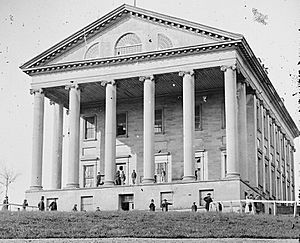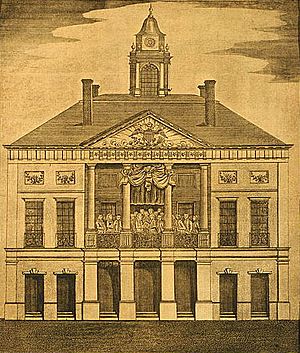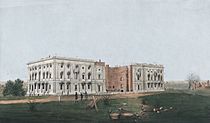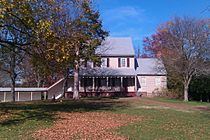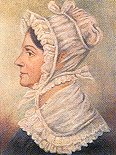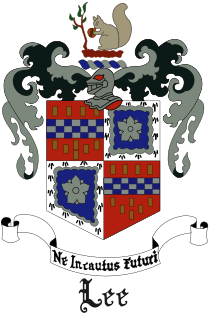Richard Bland Lee facts for kids
Quick facts for kids
Richard Bland Lee
|
|
|---|---|
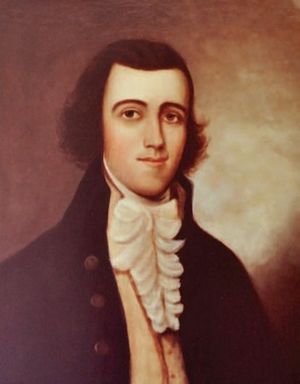 |
|
| Member of the Virginia House of Delegates from Fairfax County | |
| In office 1799 |
|
| Preceded by | Roger West |
| Succeeded by | Nicholas Fitzhugh |
| Member of the Virginia House of Delegates from Loudoun County | |
| In office November 8, 1796 - December 3, 1797 |
|
| Preceded by | Stacey Taylor |
| Succeeded by | Samuel Clapham |
| In office June 23, 1788 - October 18, 1789 |
|
| Preceded by | Josiah Clapham |
| Succeeded by | Albert Russell |
| In office May 3, 1784 – October 15, 1787 |
|
| Preceded by | Stevens Thomson Mason |
| Succeeded by | Josiah Clapham |
| Member of the U.S. House of Representatives from Virginia's 17th district |
|
| In office March 4, 1793 – March 3, 1795 |
|
| Preceded by | District established |
| Succeeded by | Richard Brent |
| Member of the U.S. House of Representatives from Virginia's 4th district |
|
| In office March 4, 1789 – March 3, 1793 |
|
| Preceded by | District established |
| Succeeded by | Francis Preston |
| Personal details | |
| Born | January 20, 1761 "Leesylvania", Virginia Colony, British America |
| Died | March 12, 1827 (aged 66) Washington, D.C., U.S. |
| Nationality | American |
| Political party | Pro-Administration Party |
| Spouse | Elizabeth Collins |
| Relations | Brother of Major Gen. Henry ("Light Horse Harry") Lee III, Brother of Attorney General Charles Lee, Uncle of Robert E. Lee |
| Children | Mary Ann Lee Richard Bland Lee II Ann Matilda (Lee) Washington Mary Collins Lee Cornelia (Lee) Marcrae Zaccheus Collins Lee Laura Lee Nancy Ruth (Lee) Todd (Lee and his wife were also the parents of two stillborn children) |
| Residence | Sully |
| Alma mater | The College of William and Mary |
| Occupation | Planter, judge |
| Signature | |
Richard Bland Lee (born January 20, 1761 – died March 12, 1827) was an important person from Fairfax County, Virginia. He was a farmer, a judge, and a politician. He was the son of Henry Lee II and Lucy Grymes. His brothers were Henry ("Light Horse Harry") Lee, a famous general, and Charles Lee, who was the Attorney General for the United States. Richard Bland Lee was also the uncle of Robert E. Lee.
Contents
Early Life and Education
Richard Bland Lee was born on January 20, 1761. His family lived at "Leesylvania," a large estate in Prince William County, Virginia. This estate was built by his father and overlooked the Potomac River. Richard was named after two important relatives: his great-grandfather Richard Bland and his great-uncle, Richard Bland, a well-known judge.
Richard went to the College of William and Mary in 1779. Even though he didn't fight in the American Revolutionary War like his brother Henry, he cared deeply about America's fight for freedom. He joined the Phi Beta Kappa Society, an academic group that helped him improve his public speaking skills.
His father gave him land on Cub Run, which Richard started managing around 1780. In 1787, he inherited about 1,500 acres of this land. This land later became his famous estate, "Sully."
Public Service and Politics
Richard Bland Lee spent many years serving the public. He was elected to different government roles.
Serving in the Virginia House of Delegates
Voters in Loudoun County chose Richard Bland Lee to represent them in the Virginia House of Delegates several times. He served from 1784 to 1788 and again in 1796. During his time there, he strongly supported the new United States Constitution. He believed it was a good plan for the country.
He also supported James Madison to become one of Virginia's first U.S. Senators. Richard Bland Lee worked hard to make sure people knew Madison supported adding a Bill of Rights to the Constitution. Even though Madison didn't become a Senator then, he later won a tough race for Congress.
Richard Bland Lee noticed that Patrick Henry was a very powerful speaker. He felt that those who supported the new government were "young and inexperienced" compared to Henry. Even so, Congress eventually passed the first ten amendments, which became the Bill of Rights.
Serving in the U.S. House of Representatives
In 1788, Richard Bland Lee decided to run for the new United States House of Representatives. At this time, political parties were just starting to form. People who supported a strong federal government were called Federalists. Those who wanted less federal power and a Bill of Rights from the start were called Anti-Federalists. Richard Bland Lee was a Federalist. He strongly supported the Constitution and George Washington.
He won the election and became the first representative for Northern Virginia in the U.S. House of Representatives. He served three terms, from 1789 to 1795. He was part of the Compromise of 1790. This agreement helped decide where the nation's capital, Washington, D.C., would be located. His support for Federalist ideas eventually led to him losing his seat in 1794.
After leaving Congress, Richard returned to the Virginia House of Delegates. He was elected by Loudoun County voters in 1796 and by Fairfax County voters in 1799.
Other Government Roles
After moving to Washington, D.C., in 1815, Richard Bland Lee was appointed by President James Madison to help rebuild government buildings. These buildings had been damaged by British troops during the War of 1812.
Later, President Madison appointed him to handle claims for property lost or destroyed during the war. This job was difficult, and some in Congress criticized his office. However, Richard Bland Lee himself was found to be honest.
In 1819, President James Monroe appointed him as a judge for the Orphans' Court of the District of Columbia. He held this position until he passed away in 1827.
Societies
In the 1820s, Richard Bland Lee was a member of the Columbian Institute for the Promotion of Arts and Sciences. This was a respected group that included famous people like former presidents Andrew Jackson and John Quincy Adams.
Life as a Planter
When his father died in 1787, Richard Bland Lee inherited about 3,000 acres of land. He had already been managing part of this land since 1781. He named his estate "Sully." The name might have come from a French castle or from the writings of a French finance minister.
When he was in Congress, his brother Theodorick helped manage Sully. Construction on the main house at Sully began in 1794 and was finished in 1795. It was a large, beautiful home built in the Federal or Georgian style.
Richard Bland Lee was determined to farm differently. Instead of growing only tobacco, which could wear out the soil, he grew various crops. He planted wheat, rye, corn, and fruit trees. He also used methods like crop rotation and adding limestone to the soil to keep it healthy. He stopped or greatly reduced growing tobacco at Sully. He also built a dairy house in 1801.
Due to financial difficulties, Richard sold "Sully" in 1811 to a cousin. He and his wife moved to different homes, eventually settling in Washington, D.C.
Today, Sully is a museum house. It is owned and managed by the Fairfax County Park Authority and is open to visitors.
Marriage and Family
Richard Bland Lee married Elizabeth Collins in 1794. She was from Philadelphia, Pennsylvania. Elizabeth was a lifelong friend of Dolley Madison, who was the wife of President James Madison.
Richard and Elizabeth had several children:
- Mary Ann Lee (1795–1796)
- Richard Bland Lee II (1797–1875)
- Ann Matilda Lee (1799–1880)
- Mary Collins Lee (1801–1805)
- Laura Lee (born 1803, died in infancy)
- Cornelia Lee (1804–1876)
- Zaccheus Collins Lee (1805–1859), who became a U.S. District Attorney.
They also had two sons who were stillborn.
Death
Richard Bland Lee passed away in Washington, D.C., on March 12, 1827. He was first buried in the Congressional Cemetery there. In 1975, his remains were moved and reburied at his former home, the Sully Plantation, near Chantilly, Virginia. His home is now a county park that people can visit.
See also
 In Spanish: Richard Bland Lee para niños
In Spanish: Richard Bland Lee para niños


